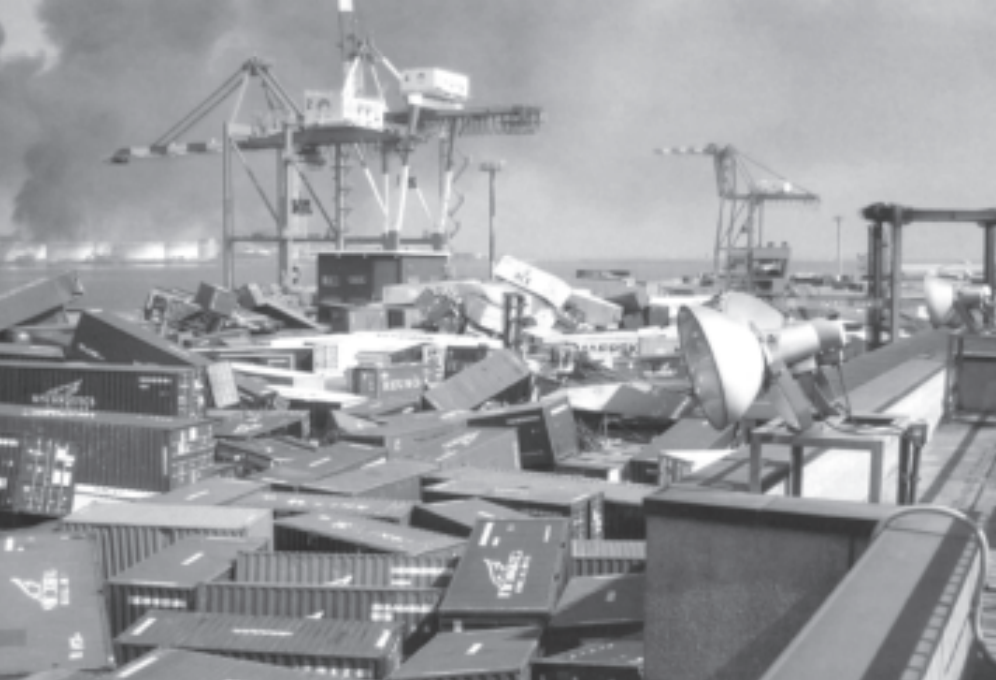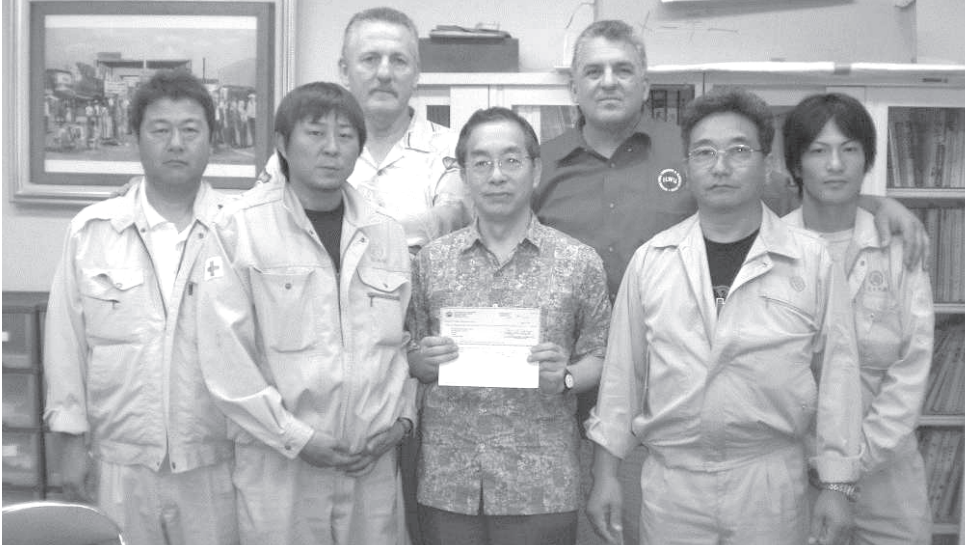The National Federation of Dockworkers’ Unions of Japan (Zenkoku-Kowan) presented this report to update supporters and donors on the relief and reconstruction efforts by Japanese dock workers.
Our country has been badly affected by the big earthquake and tsunami on March 11 and subsequent nuclear accidents at the Fukushima nuclear power plant.
In the wake of the disaster, ZenkokuKowan received very warm letters of condolences and encouragement from International Transport Workers’ Federation (ITF) officials including Paddy Crumlin , the ITF General Secretary and Frank Leys, the Dockers’ Section Secretary as well as our sister unions around the globe. The ITF and many of our brother unions kindly offered us financial support too. On behalf of all the transport workers in Japan, we would like to take this opportunity to express our gratitude for your warm support and encouragement.
Supported by solidarity expressed by our friends both home and abroad, the members of Zenkoku-Kowan who were directly affected by the disaster have been playing an active role in national efforts toward reconstruction.
As a way of showing our appreciation to our friends in the world, we would like to report on the current situation in the disaster-stricken areas and ZenkokuKowan members’ rescue efforts and their activities towards reconstruction.
The devastation of the earthquake and tsunami
At 14:46 on 11 March, an earthquake measuring 9.0 on the Richter scale struck northeast Japan. The megathrust earthquake triggered a tsunami of up to 10 meters in height, which inflicted serious damage on the northeast region. The epicenter was located off the northeast coast of Japan and five coastal prefectures, Aomori, Iwate, Miyagi, Fukushima and Ibaraki were affected by the tsunami. The tsunami-hit area stretched 500 kilometers in length. As of 1 June 2011, three months after the quake, the death toll had reached 15,310. 8,404 people are still missing and 100,527 people are living in evacuation centers. 102,271 houses have been destroyed and 63,636 have been partially demolished.
There were 13 ports in the disasterstricken areas. At most of the ports, seawalls, quays and cargo handling equipment were badly damaged, making it impossible for these ports to operate for a while. Most of the Zenkoku-Kowan’s branch offices in the areas were either washed away or flooded. About 2,000 Zenkoku-Kowan members were mainly living in six of the 13 ports. Eight members were killed and about 200 houses of Zenkoku-Kowan members were all or partially destroyed.

The destruction of the container yard at the Sendai-Shiogama Port shows the extent of the damage caused by the March 11 earthquake and tsunami which hit the North-East regions of Japan.
Efforts to address the effect of the disaster
Immediately after the 3.11 quake, Zenkoku-Kowan set up a disaster relief headquarters, and despite the poor communication infrastructure, ZenkokuKowan has been working hard to locate its members. Usually March is the month for annual wage negotiations for most of the Zenkoku-Kowan-affiliated dockers’ unions; central negotiations for various system changes in each sector of the port industry are also held in March. This year, however, we immediately suspended the ongoing negotiations and decided to focus all our energy and efforts on the support of affected members.
First of all, we worked hard to establish good communication networks with people in the disaster stricken areas. By closely communicating with the government and those in the affected areas, we managed to secure a sea route for the transport of relief supplies, while we made temporary repairs on the ports. Thanks to these efforts, within two weeks, all of the 13 ports resumed part of their cargo handling operations. Members in the disaster-stricken areas, some of whom lost families and houses themselves, have played pivotal roles in the rescue work by handling the cargoes of relief supplies with a strong desire to make a difference in the lives of as many people as possible.
The work to remove rubble from port areas is nearing an end and ships are gradually coming back to the ports. However, unless local manufacturing regains its strength, the amount of cargo will never return to pre-disaster levels. The disasterhit port workers are maintaining their employment by working in neighboring ports with a relatively high level of recovered cargo volume. Employer associations are also supporting workers by temporarily lending used cargo handling equipment to ports in affected areas on a long-term basis. In addition, trade unions and port operating companies are collaborating with each other through rescue work councils they jointly set up both at the central and local level (in disaster-stricken areas).
Fukushima Nuclear Power Plant accident
What has worsened the situation is the accident at the Fukushima Daiichi nuclear power plant. Although the nuclear reactors in the plant automatically shut down following the earthquake, the diesel generators, which were supposed to power an emergency core cooling system didn’t work. It has become clear that the fuel rods melted down and dropped to the bottom of their pressure vessels. Now, the melted cores are being cooled down by injected water. At the No. 1 and No. 3 reactors, radiation was released when hydrogen explosions occurred. Particularly, radiation released from the No. 3 reactor, which uses mixed uranium-plutonium fuel, has very high toxicity. Even the No. 4 reactor whose operation had been suspended, leaked radioactive substances from the spent nuclear fuel. Furthermore, high-level contaminated water is being released into the sea. The situation is still uncontrollable. Tokyo Electric Power Co. said that the cooling system would be recovered by the end of the year, but work has not gone smoothly.

ILWU President Robert McEllrath (rear left) and ILWU Vice President Ray Familathe, (rear right) present a check for $65,000 to representatives of the All Japan Dockworkers Union (Zenkowan) for relief efforts. The money was donated from the ILWU International, the Coast Longshore Division, Hawaii’s Longshore Division, Hawaii Local 142 and other ILWU Locals. In the front row from Zenkowan are: Shinji Takagi (Vice President of the Onahama Local), Jun Hakozaki (Vice President of the Onahama Local), Akinobu Itoh (President), Hideki Niiduma (President of the Onahama Local), Nobuhide Sasaki (Deputy General Secretary of the Onahama Local).
The government designated the area within a 20-km radius from the plant off-limits and advised residents within a 20-30 km radius to evacuate. There is a possibility that these areas would become uninhabitable for decades to come.
Radiation measurements in ports in Japan
There is a possibility that cargo transported from Japan is contaminated with radiation. Radiation checks on cargo from Japan are carried out in a number of countries. There were cases reported that cargo was returned to Japan due to the detection of high levels of radiation.
The Ministry of Land, Infrastructure, Transport and Tourism of Japan developed guidelines on radiation measurement for export containers and ships, under which radiation checks have been carried out since 20 April 2011.
With regard to export containers, radiation levels are measured at the terminal gate at a point 1.5m above ground level on four surfaces (fore, aft, right and left) when the tractor is removed. When the tractor is connected, it is measured on three surfaces (aft, right and left). When the measured dose rates of radiation are all less that 0.3 µ Sv/h, the container should be handled as normal. When one of the measure rates is between 0.3 and 5 µ Sv/h, measures for decontamination such as washing should be taken. When the rate is 5 µ Sv/h or more, related organizations must be informed and the container should be removed and isolated. With regard to ships, dose rates are measured at five points in total: four points for the deck and one point in the vicinity of forecastle. Furthermore, radiation levels of seawater within ports are also measured.
Up until now, most of the containers have been handled as normal. There were very few cases where containers were decontaminated. Decontaminated containers are to be exported after the dose rate falls below the criteria. No radioactive substances have been detected in seawater with ports.
Right after the Chernobyl nuclear accident, port workers in Japan measured radiation levels of containers transported to Japan from Siberia. Looking back, the criteria we followed at the time was very high. In order to ensure safety of port workers and seafarers, it is necessary to share information and take appropriate measures.
